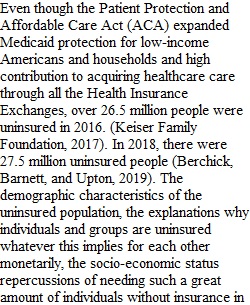


Q Instructions Supporting Lectures: Review the following lecture: • Regulatory vs. Allocative Health Policies Uninsured Americans Over the next few weeks, you will explore many of the critical components of the United States healthcare system and elements that can be improved with appropriate healthcare policy. One of the most important pieces of legislation impacting healthcare is the ACA, which “provides Medicaid coverage to many low-income individuals in states that expand and Marketplace subsidies for individuals below 400% of the poverty line” (Kaiser Family Foundation, 2017, para. 1). But, while the ACA has reduced the number of uninsured Americans, there are still millions without coverage. The question is why and what can be done to address the underlying issues. Please review the following resources and using specific information from these resources, your course resources, and additional research, address the tasks posed below: • Kaiser Family Foundation. (2017, September 19). Key facts about the uninsured population. Retrieved from https://www.kff.org/uninsured/fact-sheet/key-facts-about-the-uninsured-population/ • Krueger, A. B., & Kuziemko, I. (2013). The demand for health insurance among uninsured Americans: Results of a survey experiment and implications for policy. Journal of health economics, 32(5), 780–793. Retrieved from http://www.nber.org/papers/w16978.pdf Tasks: • Summarize the population (number, demographics, etc.) of uninsured people in the U.S. • Discuss some of the reasons for and possible financial consequences of not having health insurance. • Discuss the socioeconomic consequences of having a large uninsured population in the U.S. • Describe the changes that will occur to assist the uninsured population with the Patient Protection and ACA. Submission Details: • Present your response in a 3- to 5-page Microsoft Word document formatted in APA style. • On a separate page, cite all sources using APA format. • Name your document SU_MHA6050_W1_LastName_FirstInitial.doc. For example, if your name is John Smith, your document will be named SU_MHA6050_W1_Smith_J.doc. • By the due date assigned, submit your work to the Submissions Area. Reference: • Kaiser Family Foundation. (2017, September 19). Key facts about the uninsured population. Retrieved from https://www.kff.org/uninsured/fact-sheet/key-facts-about-the-uninsured-population/
View Related Questions